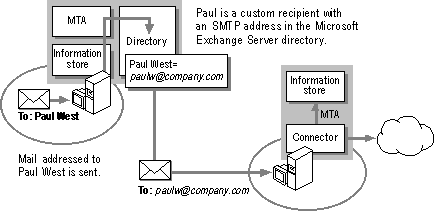
Addresses are made up of several components, each of which is used for a specific purpose. Not all addresses have all components.
Distinguished Names The native Microsoft Exchange Server address format. Microsoft Exchange Server creates a distinguished name for every object in the directory, such as a mailbox, public folder, or distribution list. The MTA uses the distinguished name to route messages within the Microsoft Exchange Server organization. A distinguished name can be used to identify a custom recipient.
When Microsoft Exchange Server cannot use a distinguished name (for example, when there is no distinguished name to use or the distinguished name is invalid), it uses the X.400 address of the object to route the message. For this reason, you must retain the X.400 address for every object in the directory, even if you are not connecting to another X.400 system.
X 400 O/R Addresses The native X.400 address type. An originator/recipient address (or O/R name) consists of either the distinguished name or an X.400 O/R address, or both. Users of a message transfer system are identified by an O/R name, which is included in the P1 message header. The message header is used to route and deliver the message. The O/R address consists of required and optional fields that contain both standard O/R attributes and various domain-defined attributes.
A one-off routing address is a manually entered O/R address that is not held in the directory and therefore has no distinguished name. A valid X.400 O/R address is required for routing out of the site, even if only a DDA is specified in the one-off routing address.
Domain Defined Attributes (DDAs) Optional fields within the O/R address that are defined by the recipient's domain. Under X.400 protocols, up to four DDAs are allowed. For example, the SMTP DDA might be John.Doe@isp.com. Other DDAs define other address attributes. DDAs also are used with custom or third-party gateways.
Target Address A DDA that identifies the address type required by the recipient system.
Custom Recipient Addresses A recipient on a foreign system that has an address stored in the Microsoft Exchange Server directory is called a custom recipient. Each custom recipient has only one target address, but can also have multiple proxy addresses of different types. The target address type matches the native mail system that delivers mail to the particular custom recipient.
When a message is routed to a custom recipient, the distinguished names of the recipient and originator are replaced in the message header with addresses of the type used in the recipient's native system. This ensures the message can be delivered to the foreign system and that a reply can be routed back to the originator with the correct address type. The conversion of a recipient address is illustrated here.

If the recipient is not in the Microsoft Exchange Server directory, the originator must write the address in the form required by the foreign system. In this case, only the originator's address is converted to the native format of the foreign system.
For more information about site and recipient addresses, see Microsoft Exchange Server Concepts and Planning. For information about how to view and modify site and recipient addresses, see Microsoft Exchange Server Operations.